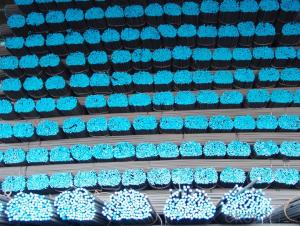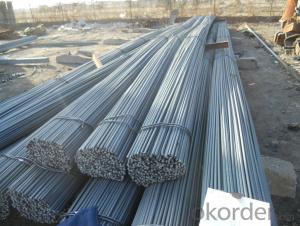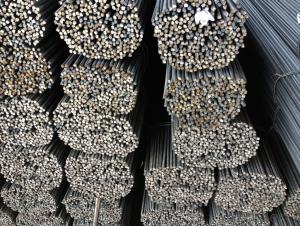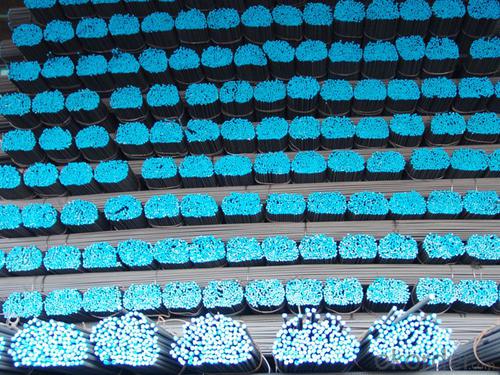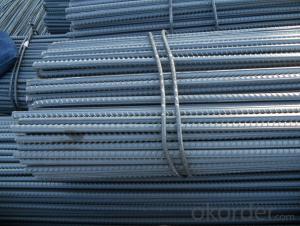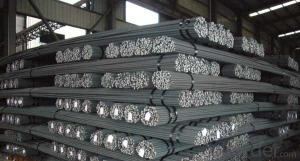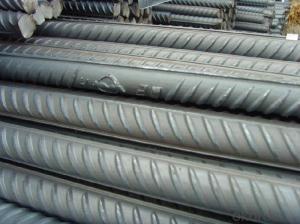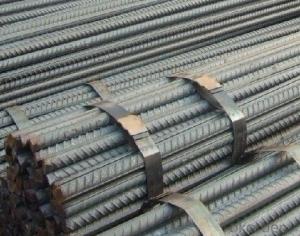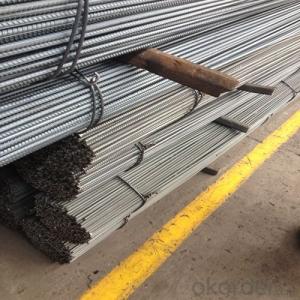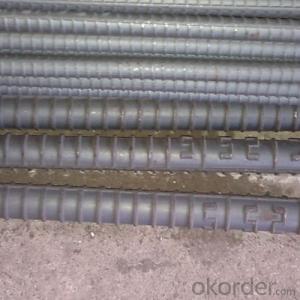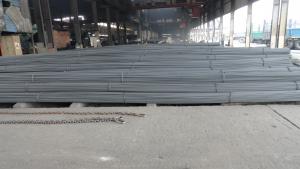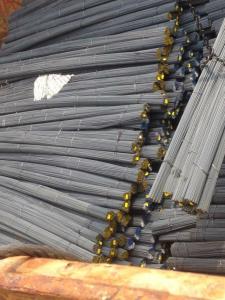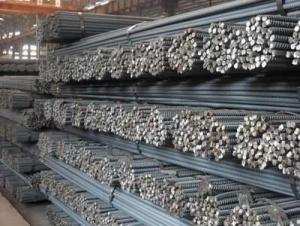Hot Rolled Steel Rebars Deformed bar ASTM
- Loading Port:
- China Main Port
- Payment Terms:
- TT or LC
- Min Order Qty:
- 100 m.t.
- Supply Capability:
- 10000 m.t./month
OKorder Service Pledge
OKorder Financial Service
You Might Also Like
Product Description:
OKorder is offering Hot Rolled Steel Rebars Deformed bar ASTM at great prices with worldwide shipping. Our supplier is a world-class manufacturer of steel, with our products utilized the world over. OKorder annually supplies products to African, South American and Asian markets. We provide quotations within 24 hours of receiving an inquiry and guarantee competitive prices.
Product Applications:
Hot Rolled Steel Rebars Deformed bar ASTM are ideal for structural applications and are widely used in forest region, Mines, factories and construction sites laid of the place such as temporary transport line and light motorcycles with line..
Product Advantages:
OKorder's Hot Rolled Steel Rebars Deformed bar ASTM are durable, strong, and wide variety of sizes.
Main Product Features:
· Premium quality
· Prompt delivery & seaworthy packing (30 days after receiving deposit)
· Can be recycled and reused
· Mill test certification
· Professional Service
· Competitive pricing
Product Specifications:
Manufacture: Hot rolled
Grade: HRB335,HRB400,HRB500
Certificates: ISO, SGS, BV, CIQ
Diameter:10mm-32mm
Packing: products are packed in coils and shipped by break bulk or containers
FAQ:
Q1: How many tons of steel products could be loaded in containers?
A1: Usually the steel products are delivered by bulk vessel because of the large quantity and the freight. However, there are no bulk vessel enter some seaports so that we have to deliver the cargo by containers. The 6m steel product can be loaded in 20FT container, but the quantity is changed according to the size, usually from 18tons to 25tons.
Q2: what is the difference between actual weight and theoretical weight?
A2: All the section steel has two weights: actual weight and theoretical weight. Actual weight is the weighing out when the product delivered from the mill. Theoretical weight is calculated by pieces. The invoice can be based on each of them as your request.
Q3: How soon can we receive the product after purchase?
A3: Within three days of placing an order, we will arrange production. The normal sizes with the normal grade can be produced within one month. The specific shipping date is dependent upon international and government factors, the delivery to international main port about 45-60days.
Images:
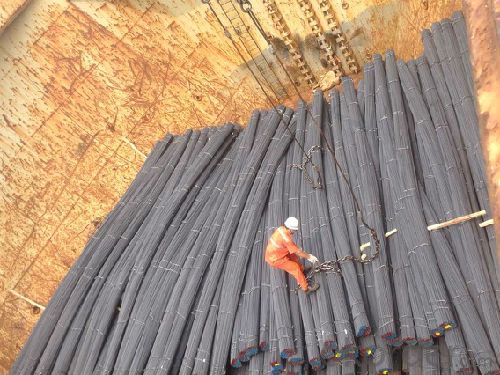
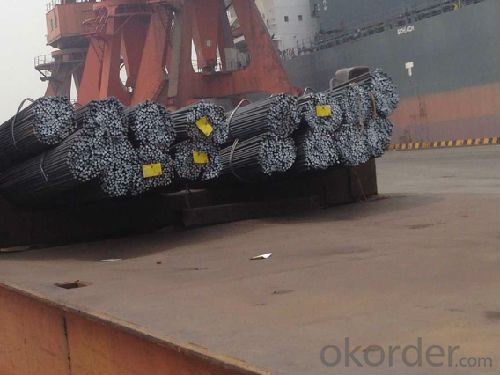
- Q: What are the marking of the steel bars on the mills? Which factory is the 2LG16 thread?
- 2LG16 thread manufacturer is the Laiwu iron and steel works, referred to as "Laiwu Steel", the letter "LG", indicating that the steel produced by the diameter of 16 of the two grade thread steel.
- Q: Can steel rebars be used in structures exposed to extreme temperatures?
- Yes, steel rebars can be used in structures exposed to extreme temperatures. Steel has high thermal conductivity, which allows it to transfer heat quickly, minimizing the risk of structural damage due to thermal expansion or contraction. However, it is essential to consider the specific temperature range and the potential impact on the structural integrity of the rebar. In extremely high temperatures, other materials or protective measures may be necessary to ensure the stability and safety of the structure.
- Q: What is the impact resistance of steel rebars?
- Steel rebars have a high impact resistance due to their robust and durable nature. They can withstand heavy loads, shocks, and external forces, making them an ideal choice for reinforcing concrete structures.
- Q: What are the guidelines for proper anchoring of steel rebars in concrete structures?
- The guidelines for proper anchoring of steel rebars in concrete structures involve several key steps. Firstly, the rebars should be placed at the correct depth within the concrete to ensure sufficient bonding and structural integrity. It is important to clean the rebars thoroughly before installation to remove any dirt or debris that may hinder the bond. Additionally, the rebars should be positioned at the appropriate spacing and secured in place using rebar chairs or supports to maintain their correct position during the concrete pouring process. Adequate concrete cover should be provided around the rebars to protect them from corrosion and fire damage. Lastly, proper curing of the concrete is essential to allow the rebars to effectively bond and provide the necessary strength to the structure. Overall, following these guidelines ensures the reliable anchoring of steel rebars and enhances the overall durability and safety of the concrete structure.
- Q: What are the guidelines for proper placement of steel rebars in concrete structures?
- The guidelines for proper placement of steel rebars in concrete structures include ensuring that rebars are properly positioned and supported within the concrete to provide adequate reinforcement. This involves following the specified spacing, cover, and lap length requirements as outlined in the structural design drawings. Additionally, rebars should be properly tied and secured to maintain their position during the concrete pouring process. Adherence to these guidelines is crucial to ensure the structural integrity and durability of the concrete structure.
- Q: What is the average tensile strength of steel rebars?
- Steel rebars typically have an average tensile strength ranging between 400 and 600 megapascals (MPa). It should be noted that the grade and type of steel used in the manufacturing process can cause variations in the specific tensile strength. Tensile strengths above 600 MPa can be achieved with higher grades of steel rebars. Moreover, the tensile strength of the rebars can also be influenced by factors like their diameter and surface condition.
- Q: What is the role of steel rebars in column and beam construction?
- Steel rebars play a crucial role in column and beam construction as they provide reinforcement, strength, and stability to the structure. In reinforced concrete construction, columns and beams are typically made of concrete, which is strong in compression but relatively weak in tension. This is where steel rebars come in. Rebars, also known as reinforcing bars, are long steel rods that are strategically placed within the concrete to counteract its weakness in tension. They are typically made of high-strength steel and are designed to withstand the tensile forces that occur in a structure. By adding rebars to the concrete, the resulting composite material can resist both compression and tension, making it much stronger and more durable. In column construction, steel rebars are placed vertically and tied together in a grid-like pattern. This reinforcement helps the column support the weight of the structure and resist vertical loads, such as the weight of the floors or roof above. The rebars also help to prevent the column from buckling or collapsing under these loads. Similarly, in beam construction, steel rebars are placed horizontally within the concrete beam. These rebars help the beam to resist bending and shear forces, which are common in structural elements that span across openings or support loads from above. By providing reinforcement, the rebars ensure that the beam remains stable and can safely bear the imposed loads. Overall, the role of steel rebars in column and beam construction is to enhance the strength, stability, and load-bearing capacity of the structure. They effectively improve the structural integrity of the concrete elements, allowing them to withstand the various forces and loads they will be exposed to throughout their lifespan. Without the presence of rebars, columns and beams would be much weaker and more susceptible to failure, compromising the safety and longevity of the overall structure.
- Q: What are the different methods for attaching steel rebars to existing structures?
- There are several methods for attaching steel rebars to existing structures, depending on the specific requirements and conditions of the project. Some common methods include: 1. Welding: This method involves using welding techniques to attach the rebars to the existing structure. It provides a strong and durable connection, but it requires skilled labor and may not be suitable for all situations. 2. Epoxy bonding: Epoxy adhesives can be used to bond rebars to existing structures. This method is easy to apply and provides a reliable connection, especially when the rebars are embedded in concrete. However, it is important to ensure proper surface preparation and follow manufacturer's instructions for best results. 3. Mechanical anchoring: Mechanical anchors, such as anchor bolts or expansion anchors, can be used to attach rebars to existing structures. This method involves drilling holes into the structure and inserting the anchor, which provides a secure connection. It is important to select the appropriate anchor type and size based on the load requirements and structural conditions. 4. Clamping or fastening: In some cases, rebars can be attached to existing structures using clamps or fasteners. This method is relatively quick and easy to install, but it may not provide as strong of a connection as welding or epoxy bonding. 5. Overlapping: When reinforcing existing concrete structures, rebars can be overlapped with the existing reinforcement and tied together using wire or other methods. This method is commonly used in construction to ensure continuity of reinforcement and increase the load-carrying capacity. It is important to consult with structural engineers or professionals with expertise in rebar installation to determine the most suitable method for attaching steel rebars to existing structures. They will consider factors such as structural integrity, load requirements, and local building codes to ensure a safe and effective connection.
- Q: How do steel rebars prevent cracks in concrete structures?
- Steel rebars prevent cracks in concrete structures by providing reinforcement and increasing the tensile strength of the concrete. When concrete is exposed to tensile forces, such as those caused by external loads or temperature changes, it tends to crack. However, steel rebars, which are embedded within the concrete, act as a reinforcement and absorb these tensile forces. The rebars distribute the load more evenly throughout the structure, preventing localized stress and minimizing the formation of cracks.
- Q: How do steel rebars affect the overall fire safety of a structure?
- Steel rebars can have both positive and negative effects on the overall fire safety of a structure. On one hand, steel rebars can contribute to the strength and stability of the structure, helping it withstand the impact of a fire and preventing structural collapse. This is especially important in high-rise buildings or structures that are vulnerable to fire hazards. Moreover, steel rebars have a high melting point, making them more resistant to heat compared to other building materials. This can help slow down the spread of fire and provide additional time for evacuation or firefighting measures. However, steel rebars can also have some negative effects on fire safety. When exposed to high temperatures, steel expands, which can lead to structural deformations and potential failure of the rebars. This can compromise the integrity of the structure and increase the risk of collapse. Additionally, steel rebars conduct heat, which means they can transfer heat from the fire to other parts of the structure. This can cause localized heating and weaken nearby materials, potentially leading to a faster spread of fire within the building. To mitigate these negative effects, fire-resistant coatings or fireproofing materials can be applied to the steel rebars. These coatings can provide insulation and protect the rebars from high temperatures, delaying their failure and reducing the risk of structural collapse. In conclusion, while steel rebars can enhance the overall fire safety of a structure by providing strength and stability, they also have some drawbacks. Proper fire protection measures, such as fire-resistant coatings, are crucial to ensure the rebars perform optimally in the event of a fire.
Send your message to us
Hot Rolled Steel Rebars Deformed bar ASTM
- Loading Port:
- China Main Port
- Payment Terms:
- TT or LC
- Min Order Qty:
- 100 m.t.
- Supply Capability:
- 10000 m.t./month
OKorder Service Pledge
OKorder Financial Service
Similar products
Hot products
Hot Searches
Related keywords
